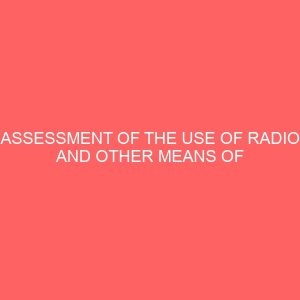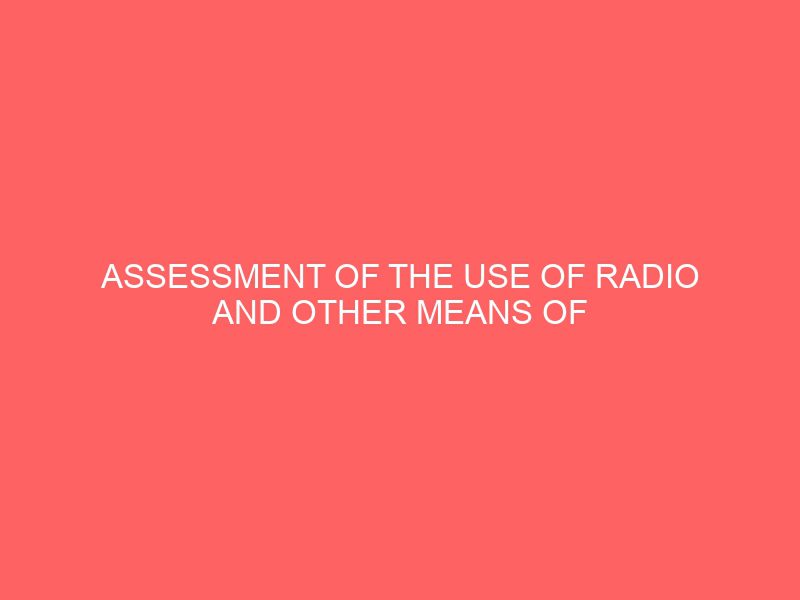Description
ASSESSMENT OF THE USE OF RADIO AND OTHER MEANS OF INFORMATION DISSEMINATION
CHAPTER ONE
INTRODUCTION
1.1 BACKGROUND OF THE STUDY
Information is very important in any society it is a veritable tool in the realization of individual resource required in any society; thus the acquiring and using information are critical and important activities. Users of information use it for different reasons, some use it for health; others use it for advancement in knowledge, others for politics. Issa (1997) cited Muhammed, (1994) opined that it is a vital resource which proves impetus for a nation social, cultural, spiritual, political, economic, scientific and technological advancement greater socio-political equity; efficient governance, power and fellowship. Thus, one can rightly infer from above that information has always played an important role in human life; hence a basic human need.
1.2 STATEMENT OF PROBLEM
Information means different thing to different people, some it may be inform of news on radio or television, and the print media, to some it may be a medical report which may be used for taking heath decision, to an investor, financial report of an organization as a vital information to decide whether to stake ones investment in such or to divest, to some in the stock analysis and daily trading in the stock market. To law enforcement agents information to them is a tool to carry out thorough investigation and absence of the timely and up-to-date information and lead to loss of life and properties. Information is now accepted as an important factor in the sustained development of any society because it reduces uncertainty, and enhances awareness of possible actions to take to solve problems. Lack of information is argued to act as a barrier to development because of importance of information provision in “capacity building; and “empowering communities” (Apata and Ogunrewo, 2010), cited Wakelin & Simeane, (1995) and Adimorah, (1995).
1.3 PURPOSE OF THE STUDY
Information needs, accessibility, utilization is being dictated by circumstances man finds himself. The environment that people interact with from the cradle of civilization portends serious challenges to man in the process of achieving his daily goals and objectives in the areas of economic, social, cultural and spiritual wellbeing. Information itself is not mobile but needs a vehicle of dissemination from one man to another and from one distance to another. Isa (1997) affirmed that information has to be widely dissemination regardless of whether one is an urban or rural inhabitant. The medium of this dissemination could be called a channel. Channels of information communication are interpersonal man to man through signals, signs, beckoning, language, and eye contact, town criers most especially in the primitive days and in villages.
1.4 RESEARCH QUESTION
Advancement in technology has made it possible for human being to communicate easily irrespective of geographical location through the aid of telephones, telegrams, fax, radio phone, television, e-mail, telex, internet, computer etc.
- Radio is an important tool in dissemination information to the residents of Ado-Ekiti?
- Information can be accessed with little or not cost to everybody in Ado-Ekiti?
- Which of the following is the most accessible, affordable and usable in providing access to information among the residents in Ado-Ekiti?
- What are the problems encountered in accessing information by the residents of Ado-Ekiti?
1.5 RESEARCH HYPOTHESIS
Advent of radio have tremendously transformed the way information is disseminated, prior to its invention, people most especially in primitive Africa society had their peculiar way of disseminating information such as the use of town criers and assembling people in strategic locations in the village such as market square to disseminate information to them. In primitive Yoruba society, different signs and object were used to disseminate information. Colonial masters brought radio to ease their administration and ever since it has been to pass information from government to the citizen and people use it to disseminate social and religious programs because of its capability to reach large audience. Advancement in information and communication technology has brought other means of information dissemination such as television, internet, mobile phones, fax, telex, telegram among other. The question is, with these mirage of means of disseminating information, how relevant is radio and what are the most preferred means of information dissemination among the residents of Ado-Ekiti and the cost of accessing information by the people.
1.6 SIGNIFICANT OF THE STUDY
The medium of this dissemination could be called a channel. Channels of information communication are interpersonal man to man through signals, signs, beckoning, language, and eye contact, town criers most especially in the primitive days and in villages.
Find out the significance of transistor radio in information dissemination;
Education the masses that information is very cheap and affordable to everybody;
Investigate the most available, accessible, affordable and usable in providing access to information to the residents of Ado-Ekiti;
Identify problems encounter in accessing information using these media and the possible solutions.
1.7 SCOPE OR DELIMITATION OF THE STUDY
It is very appealing because of some distinguish features of interactivity, its capacity to provoke dialogue and to solicit participation of local population with lower production costs and extreme versatility. Omenesa (1997) observed that radio programmes are usually timely and capable of extending messages to the audience no matter where they may be as long as they have a receiver with adequate supply of power. The absence of such facilities as road, light and water are no hindrance to radio.
1.8 DEFINITION OF TERMS
Assessment: It is the process and effort to anything usual is commonly used but many people.
Information: Is any entity or form that provides the answer to a question of some kind or resolves uncertainty.
Dissemination:
Radio: Radio is the technology of using radio waves to carry information, such as sound by systematically modulating proper ties of electromagnetic energy waves transmitted through special such as their amplitude frequency, phase or pulse.
Television: Is a telecommunication medium used for transmitting moving images in monochrome.
Dissemination: it is the process of sharing pieces of information to a targeted audience or the act of informing the public on the happening.








Reviews
There are no reviews yet.